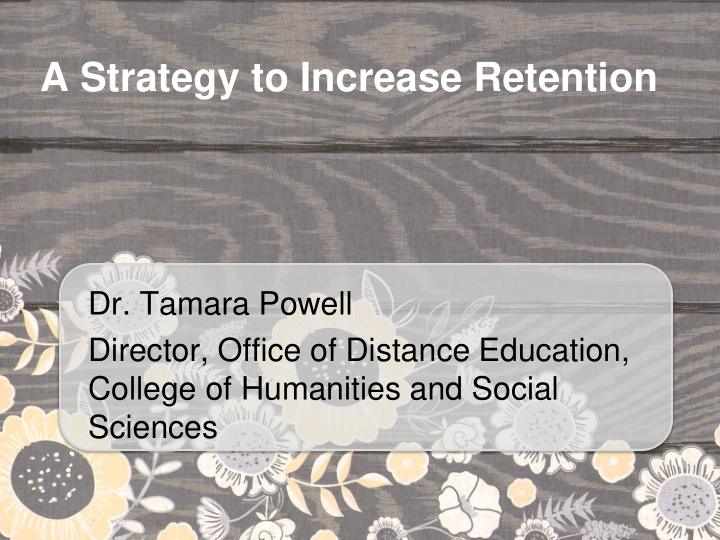



A Strategy to Increase Retention Dr. Tamara Powell Director, Office of Distance Education, College of Humanities and Social Sciences
The Education Situation • Average $24,466 per year for tuition, room, and board (Fast Facts) • Average student graduates with $27,000 in student loans (Ellis) • Majority of full time students (60%) take 7 years to earn a Bachelor’s degree (Marklein) • Majority of Americans do not have a Bachelor’s degree
Objective: A Strategy that • Increases retention • Fosters course completion • Encourages responsibility • Encourages goal setting
The Research Clear paths through courses and programs (Kamenetz) Across the centuries, the mere availability of education has not equated with greater levels of attainment. Citizens, and students, need help.
The Research Communication with the professor (Arum and Roksa) Studies show that students who communicate with their professors do better than those who do not. Students should be encouraged to communicate with their online professors via email, telephone, Skype, or other methods that are agreeable to the professor.
The Research Goal setting (Davis, Bargozzi, and Warshaw 984) By encouraging our students to set goals, we increase their chances of reaching them.
The Schedule Assignment Results (single section) 2012 WRIT 3140 evaluation average: 3.48 Retention: 26/30 (87%) Average grade C 2013 WRIT 3140 evaluation average: 3.40 Retention: 40/44 (91%) Average grade C 2014 WRIT 3140 evaluation average: 3.68 Retention: 40/42 (95%) Average grade C 2015 WRIT 3140 evaluation average: 3.56 Retention: 40/42 (95%) Average grade C
The Schedule Assignment http://www.kennesaw.edu/elearning /Smarter/Smarter4.html
Thank you! Questions?
Works Cited Aldrich, Clark. Learning Online with Games, Simulations,and Virtual Worlds: Strategies for Online Instruction . San Francisco: Jossey Bass, 2009. Arum, Richard and Josipa Roksa. Academically Adrift: Limited Learning on College Campuses. University of Chicago Press: Chicago, 2011. Electronic book. “Complete College America.” http://www.completecollege.org/. Accessed June 27, 2013. Davis, Fred D. Richard P. Bagozzi and Paul R. Warshaw. “User Acceptance of Computer Technology: A Comparison of Two Theoretical Models.” Management Science . 35.8 (1989: 982 ‐ 1003. Ellis, Blake. “Average Student Loan Debt Nears $27,000.” CNNMoney . October 18, 2012. Accessed June 27, 2013. http://money.cnn.com/2012/10/18/pf/college/student ‐ loan ‐ debt/inde x.html
“Fast Facts.” National Center for Education Statistics. Institute of Education Sciences. US Department of Education. Accessed June 27, 2013. http://nces.ed.gov/fastfacts/display.asp?id=76 Herbert, Michael. ʺStaying the Course: A Study in Online Student Satisfaction and Retention.ʺ Online Journal of Distance Learning Administration . 9.4 (2006). Kamenetz, Anya. DIY U: Edupunks, Edupreneurs, and the Coming Transformation of Higher Education . Chelsea Green Publishing Company: White Junction, VT, 2010. Markelein, Mary Beth. “4 ‐ Year Colleges Graduate 53% of Students in 6 Years.” USA Today . June 3, 2009. Accessed June 27, 2013. http://usatoday30.usatoday.com/news/education/ 2009 ‐ 06 ‐ 03 ‐ diploma ‐ graduation ‐ rate_N.htm Means, Barbara et al. Evaluation of Evidence ‐ Based Practices in Online Learning: a Meta ‐ Analysis and Review of Online Learning Studies . U.S. Department of Education: Washington, D.C., 2010.
Recommend
More recommend